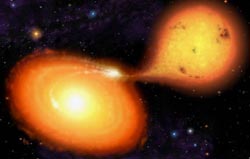Physics and Astronomy
This area deals with the fundamental laws and building blocks of nature and how they interact, the properties and the behavior of matter, and research into space and time and their structures.
innovations-report provides in-depth reports and articles on subjects such as astrophysics, laser technologies, nuclear, quantum, particle and solid-state physics, nanotechnologies, planetary research and findings (Mars, Venus) and developments related to the Hubble Telescope.

New results force scientists to rethink single-molecule wires
Single-molecule switches have the potential to shrink computing circuits dramatically, but new results from the Arizona State University lab that first described how to wire a single molecule between gold contacts now show that laboratory-standard wired molecules have an unavoidable tendency to “blink” randomly.
In the May 30, 2003, Science, Stuart Lindsay and colleagues identify the cause of this blinking behavior as random, temporary breaks in the chemical bond between the wired molecule

Hot gas around cold dust cloud surprises astronomers
New features may make southern sky’s ’Coalsack’ ideal for further study
Stargazers call a prominent dark black region in the Southern Hemisphere’s night sky the Coalsack. Even for naked-eye observers, the cloud of cold gas that makes up the Coalsack is hard to miss: It covers a part of the misty luminescence of the Milky Way, blocking out distant stars of our galaxy with the deep black shades that have earned the Coalsack its name.
A newly discovered aspect of the C

U of T Study Looks Inside ’beating Heart’ Of Lasers
A new study by University of Toronto researchers offers the first-ever glimpse inside a laser while it’s operating, a breakthrough that could lead to more powerful and efficient lasers for fibre-optic communication systems.
“We’ve seen the inner workings of a laser in action,” says investigator Ted Sargent, a professor in the Edward S. Rogers Sr. Department of Electrical and Computer Engineering. “We’ve produced a topographical map of the landscape that electrons see as they flow into these

Tiny galaxies once roared in the universe, say scientists
Astronomers led by the University of Colorado and Carnegie Observatories have shown that a miniature galaxy less than one-hundredth the size of the Milky Way is ejecting large quantities of gas and energy into huge regions of intergalactic space.
“This discovery suggests tiny galaxies that appear very faint and dormant today were once much brighter and more active,” said CU-Boulder graduate student Brian Keeney. “It also indicates similar galaxy systems may have been primarily responsible fo

Astronomers show that low-mass stars in binary stars appear to behave like high-mass, evolved stars
Astronomers Steve Howell of the University of California, Riverside and Thomas E. Harrison and Heather Osborne of New Mexico State University have found from their observations of over a dozen mass-losing stars in ’cataclysmic variables’ that most of the secondary stars do not appear to be normal main sequence stars in terms of their apparent abundances. To various degrees, each star seems to have low to no carbon and other odd mixtures of elements such as sodium and calcium, the astronomer

When is a metal not a metal?
Niobium clusters display non-metallic properties at ultra-cold temperatures
The May 23 issue of the journal Science answers that question with an account of the surprising behavior exhibited by nanometer-scale clusters of the metal niobium. When the clusters are cooled to below 20 degrees Kelvin, electrical charges in them suddenly shift, creating structures known as dipoles.
“This is very strange, because no metal is supposed to be able to do this,” said Walter de Heer, a p